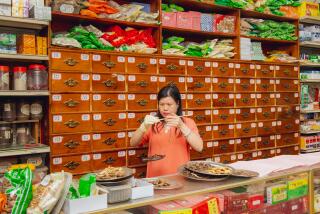Uncommon Herbs : In a Burmese Garden
- Share via
Remember when nobody knew what cilantro was? That’s the way it is today for chin baung and kin poon , Burmese greens that are usually available only in the yards of a few home growers.
It’s still possible to taste them, though. The Golden Triangle, a Burmese and Thai restaurant in Whittier, adds chin baung and kin poon to soups and stir-fries. The plants yield their emerald leaves only in summer, and the crop is so limited that it’s advisable to order these special dishes in advance.
Like many other plants from tropical climates, chin baung and kin poon do not thrive in Southern California. What’s more, once plucked and away from the sun, their leaves wither rapidly. However, local Burmese, nostalgic for the tastes of home, have managed to propagate them. And they may create a spreading demand for these exotic flavors.
In Burma (now Myanmar), chin baung is “No. 1,” says Sansan Yi Chin, one of the Golden Triangle’s three partners. “We eat it a lot; it’s very famous.” Chin baung is nicknamed “sour leaf.” When cooked, it could pass for spinach with an injection of lemon juice. Fresh, the leaves look like tiny, fragile, very green sycamore leaves.
Kin poon , which is also sour, is tough to work with. Thorns jab painfully as one juggles the branches to obtain the long, slim, edible fronds. The tiny bit of green on each frond must be stripped from the slender stem. This is tedious, slow work. And it takes a lot of fronds to make a single bowl of soup.
*
The drumstick plant, another Burmese staple, appears in other Southeast Asian cuisines too and is heavily used in Indian vegetarian curries. The Burmese use both the tender leaves and the large tough pods that yield seeds from which they grow the plant here.
Easier to come by is fresh sebelin --that’s an attempt to reproduce the Burmese word for lemon grass phonetically. Now moving into mainstream Western cookery, lemon grass is essential to Burma’s national dish, mohinga. This strongly seasoned fish soup combined with rice noodles is eaten for breakfast--and the rest of the day too.
Myin khwa , or pennywort, is in demand with Thais and Vietnamese as well as Burmese. It’s possible to buy fresh or frozen pennywort in some Asian markets, to sample fresh pennywort juice in some Vietnamese restaurants and to buy bottles and cans of pennywort drink imported from Thailand.
Pennywort juice is a Thai remedy for those who overindulge in greasy foods, says Pauli Win, partner with Sansan Yi Chin and Lily Yu in the Golden Triangle. Both Chin and Yu are Burmese. Win is Thai (her husband is Burmese), and she supervises the Thai portion of the menu.
Thais extract the juice from pennywort leaves and stems and add sugar, Win says. If you’re visiting that steamy hot-country and want to try this restorative, ask for bai bwa book juice.
*
The Burmese also drink pennywort juice. And they add the slightly bitter leaves to soup and to a fascinatingly complex salad. To make a splash at your next potluck, try this: Combine chopped pennywort leaves with chopped raw onion, roasted peanuts, sesame seeds and fried onion. Season this exotic mixture with ground dried shrimp, lemon juice and fish sauce.
Thailand and Burma are neighbors and employ some of the same ingredients, but not always in the same way. Thais don’t use chin baung leaves, for example, but only the fruit, from which they extract juice or make soup.
The Burmese turn the fruit into jam and add the leaves to soups and spicy stir-fries. An example of the latter is the Golden Triangle’s chin baung kyaw , a mixture of chin baung leaves, shrimp and bamboo shoots, seasoned powerfully with shrimp paste, hot chiles and garlic.
The Golden Triangle Restaurant, located at 7011 Greenleaf Ave., Whittier, almost always has chin baung on the menu, fresh in summer and frozen during the winter. It’s best to call the restaurant first--(310) 945-6778--to check on supplies of kin poon , pennywort and drumstick leaves. There’s less demand for these, so they’re not kept on hand.
But you’re guaranteed the opportunity to taste a salad based on one of the rarest ingredients of all--tea leaves cultivated in Burma and shipped direct to the restaurant. Called lap pad thoke , it’s always on the menu.
More to Read
Eat your way across L.A.
Get our weekly Tasting Notes newsletter for reviews, news and more.
You may occasionally receive promotional content from the Los Angeles Times.








